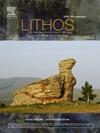长白山火山岩浆成因、岩浆管道系统和地球动力学机制:来自矿物学、地球化学和地温压资料的新证据
IF 2.5
2区 地球科学
Q2 GEOCHEMISTRY & GEOPHYSICS
引用次数: 0
摘要
长白山火山场(主要由天池火山、王天娥火山、南峰火山和图们江火山组成)位于欧亚板块东部的板内域,表现出旺盛的新生代火山活动。然而,与该活跃区火山活动相关的岩浆系统和深部地球动力学机制仍存在争议;即岩浆是来自地幔还是俯冲太平洋板块;岩浆储层是多层还是单层且规模较大;也是火山活动的动力来源。本文综合分析了上新世以来各喷发期的地球化学和年代学资料,结合已有资料,重建了长白山火山场的火山演化过程。地球化学结果显示,天池、王天阿和图门三个火山中心的微量元素模式和Sr-Nd-Pb同位素组成均匀,表明岩浆起源于软流圈地幔与俯冲太平洋板块之间的机械混合和流体熔融交代作用形成的富集地幔源。分离结晶是岩浆分异的主要机制。矿物温度气压计揭示了一个多层岩浆储存系统,包括天池火山下的浅层(约3-5公里)、中层(约8-18公里)和深层(约25-36公里)储层。与图们江火山深部岩浆源(约26 ~ 50 km)形成对比,望天峨火山岩浆源位于8 ~ 15 km和25 ~ 36 km。这些发现表明,地幔过渡带停滞太平洋板块通过物质作用和动力作用对区域火山活动起着根本的控制作用,并解决了地表火山活动与深部地幔作用的成因联系。此外,我们还用多层岩浆储层来调和前人关于地幔和俯冲太平洋板块岩浆起源的争论。本文章由计算机程序翻译,如有差异,请以英文原文为准。
Magmatic genesis, magmatic plumbing system, and geodynamic mechanism of Changbaishan volcanoes: New evidence from mineralogical, geochemical, and geothermobarometric data
The Changbaishan volcanic field (mainly comprising Tianchi, Wangtian'e, Namphothe, and Tumen River volcanoes), located in the intraplate domain of the eastern Eurasian plate, has exhibited vigorous Cenozoic volcanism. However, the magmatic system and deep geodynamic mechanisms related to the volcanic activity underlying this active region remain controversial; namely, whether the magma originates from the mantle or subducted Pacific slab; whether the magma reservoir is multi- or single-layered with a large scale; and the source of the driving force of volcanic activity. In this study, we present an integrated analysis of newly acquired geochemical and geochronological data spanning all eruptive phases since the Pliocene, combined with existing datasets, and reconstruct the volcanic evolution of Changbaishan volcanic field. Geochemical results reveal homogeneous trace element patterns and Sr-Nd-Pb isotopic compositions across the Tianchi, Wangtian'e, and Tumen volcanic centers, indicating that the magma originated from an enriched mantle source formed by the mechanical mixing and fluid-melt metasomatism between the asthenosphere mantle and subducted Pacific slab components. Fractional crystallization is identified as the dominant magma differentiation mechanism. Mineral thermobarometers reveal a multi-tiered magma storage system, with shallow (ca. 3–5 km), intermediate (ca. 8–18 km), and deep-seated (ca. 25–36 km) reservoirs beneath Tianchi volcanoes. Moreover, the magma reservoirs of Wangtian'e volcano are located at depths of 8–15 and 25–36 km, contrasting with deeper magma sources (ca. 26–50 km) beneath the Tumen River volcano. These findings demonstrate that the stagnant Pacific slab in the mantle transition zone exerts fundamental control over regional volcanism through both material contributions and dynamic forces and resolves the genetic connections between surface volcanism and deep mantle processes. Furthermore, we also reconcile previous controversies regarding the origin of magma from the mantle and subducted Pacific slab with a multi-layered magma reservoir.
求助全文
通过发布文献求助,成功后即可免费获取论文全文。
去求助
来源期刊

Lithos
地学-地球化学与地球物理
CiteScore
6.80
自引率
11.40%
发文量
286
审稿时长
3.5 months
期刊介绍:
Lithos publishes original research papers on the petrology, geochemistry and petrogenesis of igneous and metamorphic rocks. Papers on mineralogy/mineral physics related to petrology and petrogenetic problems are also welcomed.
 求助内容:
求助内容: 应助结果提醒方式:
应助结果提醒方式:


